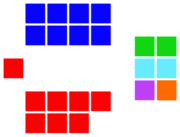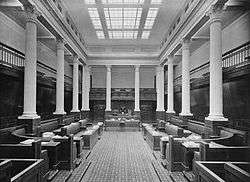South Australian Legislative Council
| Legislative Council | |
|---|---|
 | |
| Type | |
| Type | |
| History | |
| Founded | 1840 |
| Leadership | |
| Structure | |
| Seats | 22 |
 | |
Political groups |
Government Labor (8) Opposition Liberal (8) Crossbench Green (2) Family First (2) D4D (1) Nick Xenophon Team (1) |
| Meeting place | |
|
| |
|
Legislative Council Chamber Parliament House, Adelaide, South Australia, Australia | |
| Website | |
| SA Legislative Council | |
The Legislative Council, or upper house, is one of the two chambers of the Parliament of South Australia. Its central purpose is to act as a house of review for legislation passed through the lower house, the House of Assembly. It sits in Parliament House in the state capital, Adelaide. The fourth-term South Australian Branch of the Australian Labor Party has been in government since the 2002 election.
The upper house has 22 members elected for eight-year terms by proportional representation, with 11 members facing re-election every four years. It is elected in a similar manner to its federal counterpart, the Australian Senate. Casual vacancies—where a member resigns or dies—are filled by a joint sitting of both houses, who then elect a replacement.
The upper house consists of eight Labor, eight Liberal, two Green, two Family First, one Dignity for Disability and independent John Darley.
History
Advisory council
The Legislative Council was the first parliament in South Australia, having been created in 1840, seventeen years before the Assembly. It was originally appointed by the Governor, and only served in an advisory capacity, as the governor retained almost all legislative powers. It was expanded slightly in 1843, when several prominent landowners were allowed to join. In the same year, proceedings were opened to the general public.
Public demand for some form of representative government had been growing throughout the 1840s, and this was reflected in a series of reforms in 1851, which created a partially representative Legislative Council. After the changes, it consisted of 24 members, four official (filling what would be today ministerial positions) and four non-official members, both nominated by the governor on behalf of the Crown, and 16 elected members. The right to vote for these positions was not universal, however, being limited to propertied men. In addition, the reforms meant that the Governor no longer oversaw proceedings, with the role being filled by a Speaker who had been elected by the members.

Self-government
In 1856, the Legislative Council prepared what was to become the 1857 Constitution of South Australia. This laid out the means for true self-government, and created a bicameral system, which involved delegating most of its legislative powers to the new House of Assembly. While all adult males could vote in the new Assembly, the Council continued to limit voting rights to the wealthier classes; suffrage was dependent on certain property and wage requirements. Women earned the right to vote in the Council at the same time as the Assembly, in 1895, the first Parliament in Australia to do so, under the radical Premier Charles Kingston.[1]
The council had its purpose in replicating the British House of Lords as a restricted 'house of review' in a colonial context. When the Province of South Australia received its original constitution in 1857, it was the most democratic in the British Empire, combining a universal-suffrage lower house (the House of Assembly), with a restricted-suffrage upper house (the Legislative Council). The purpose of the Legislative Council was, as with the 19th century House of Lords, to safeguard the "longer term interests of the nation rather than just reacting to short term ephemeral issues of the day".
The council's numbers have varied. From inception to 1902 it had 24 members; until 1915, 18 members; and until 1975, 20 members. The electoral districts were drawn to favour regional areas with a 2:1 bias in place, with half of the council being elected each time. From 1915 to 1975, Labor did not gain more than two members at each election, with the conservative parties always holding a sizeable majority.
The conservative members in the council were very independent, and differed markedly from their counterparts in the House of Assembly. During the long reign of Liberal and Country League (LCL) Premier Sir Thomas Playford, they would prove to be an irritant, and Labor support was sometimes required for bills to pass. When a Labor government was eventually elected in 1965 and began introducing social legislation that was anathema to LCL councillors, they would delay, obstruct and modify such bills. The councillors, however, saw their actions (in the words of MLC Sir Arthur Rymill) necessary to "oppose... radical moves that I feel would not be in the permanent will of the people."[2] The House of Assembly contained some progressive Liberals, and its membership would usually abide by the party line. The council contained none, and its members rebelled regularly against the decisions of the party leadership and the popular will of the people.
Universal suffrage
Even after electoral legislation had been implemented in 1967 by Steele Hall that produced a fairer electoral system for the House of Assembly, the council remained unchanged. It was only in 1973 under Don Dunstan that changes were finally made. Dunstan, a social reformist, tired of the council's obstructionist attitude, and put forward bills for its reform. Initially rejected by the council, the reform created a single statewide electorate of 22 members, with 11 being elected each time. It eventually passed with bipartisan support.[3]
The new council was designed to be deadlocked, and for a party majority to be hard to gain. Its proportional electoral system proved favourable to minor parties and they have usually held the balance of power. The Liberal Movement, in 1975, was the first minor party to have members elected to the council, and its successor, the Australian Democrats, held the balance until 1997 when independent Nick Xenophon was elected. The Family First Party and the Australian Greens gained representation in 2002 and 2006 respectively.[4]
The proportional system used in 1973 was party-list proportional representation, but this was modified in 1985. The federal government of Bob Hawke had introduced a new single transferable vote system for the Australian Senate, enabling voters to choose between voting 'above the line' (for a single party preference ticket) or 'under the line' and number all candidates in order of preference, on the ballot paper. The Bannon state government copied this arrangement for the council.[5]
Distribution of Seats
Current
| Party | Seats held | Current Council | |||||||
|---|---|---|---|---|---|---|---|---|---|
| Australian Labor Party | 8 | ||||||||
| Liberal Party of Australia | 8 | ||||||||
| SA Greens | 2 | ||||||||
| Family First Party | 2 | ||||||||
| Dignity for Disability | 1 | ||||||||
| Nick Xenophon Team | 1 | ||||||||
- The Labor government requires the vote of at least four non-government MLCs to pass legislation.
| Current (2014–18) members of the South Australian Legislative Council | |||||
|---|---|---|---|---|---|
| Labor (8) | Liberal (8) | Green (2) | Family First (2) | No Pokies (1) | Dignity for Disability (1) |
|
elected 2014: |
elected 2014: |
elected 2014: |
elected 2014: |
elected 2014: | |
|
elected 2010: |
elected 2010: |
elected 2010: |
elected 2010: |
elected 2010: | |
2010
| Party | Seats held | 2010 Council | |||||||
|---|---|---|---|---|---|---|---|---|---|
| Australian Labor Party | 8 | ||||||||
| Liberal Party of Australia | 7 | ||||||||
| SA Greens | 2 | ||||||||
| Family First Party | 2 | ||||||||
| No Pokies | 2 | ||||||||
| Dignity for Disability | 1 | ||||||||
2006–2010
| Party | 2006 | 2006 Council | 2009 | Council @ 2009 | ||||||||||||||||
|---|---|---|---|---|---|---|---|---|---|---|---|---|---|---|---|---|---|---|---|---|
| Australian Labor Party | 8 | 8 | ||||||||||||||||||
| Liberal Party of Australia | 8 | 8 | ||||||||||||||||||
| Family First Party | 2 | 2 | ||||||||||||||||||
| No Pokies | 2 | 2 | ||||||||||||||||||
| Greens SA | 1 | 1 | ||||||||||||||||||
| Australian Democrats (*) | 1 | 0 | ||||||||||||||||||
| Independents (*) | 0 | 1 | ||||||||||||||||||
- (*) Sandra Kanck was re-elected for a second eight-year term as a Democrat in 2002. In 2009, David Winderlich replaced Kanck due to her resignation. Later in 2009 Winderlich resigned from the Democrats to sit in parliament as an independent.
2002–2006
| Party | Seats held | 2002–2006 Council | ||||||||
|---|---|---|---|---|---|---|---|---|---|---|
| Liberal Party of Australia | 9 | |||||||||
| Australian Labor Party | 7 | |||||||||
| Australian Democrats | 3 | |||||||||
| Family First Party | 1 | |||||||||
| No Pokies | 1 | |||||||||
| Independents (*) | 1 | |||||||||
- (*) Terry Cameron had been elected as an Labor member, but had resigned from the party, initially sitting as an independent, and then founding the SA First party in 1999. He did not face re-election in 2002, but the party disbanded soon after the election, and Cameron subsequently returned to being an independent MLC.
1997–2002
| Party | Seats held | 1997–2002 Council | |||||||||
|---|---|---|---|---|---|---|---|---|---|---|---|
| Liberal Party of Australia | 10 | ||||||||||
| Australian Labor Party | 8 | ||||||||||
| Australian Democrats | 3 | ||||||||||
| No Pokies | 1 | ||||||||||
1993–1997
| Party | Seats held | 1993–1997 Council | ||||||||||
|---|---|---|---|---|---|---|---|---|---|---|---|---|
| Liberal Party of Australia | 11 | |||||||||||
| Australian Labor Party | 9 | |||||||||||
| Australian Democrats | 2 | |||||||||||
See also
- List of elections in South Australia
- List of South Australian Legislative Council appointments
- List of South Australian Legislative Council by-elections
- Parliaments of the Australian states and territories
- 2008 Parnell–Bressington filibuster
- Lists of Members of the South Australian Legislative Council
- South Australian state election, 2010
Notes
- ↑ Women’s Suffrage Petition 1894: parliament.sa.gov.au
- ↑ Blewett, Neal (1971). Playford to Dunstan: The Politics of Transition. Griffin Press Limited. p. 41. ISBN 0-7015-1299-7.
- ↑ Dunstan, Don (1981). Felicia: The political memoirs of Don Dunstan. Griffin Press Limited. pp. 214–215. ISBN 0-333-33815-4.
- ↑ ABC Elections. Past election results. Accessed 19-01-2007.
- ↑ ABC Elections. Legislative Council Background. Accessed 19-01-2007.